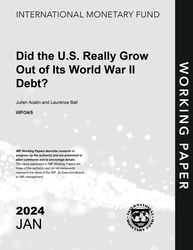
Did the U.S. Really Grow Out of Its World War II Debt?
Did the U.S. Really Grow Out of Its World War II Debt?
READ MORE...
Volume/Issue:
Volume 2024
Issue 005
Publication date: January 2024
ISBN: 9798400262999
$20.00
Add to Cart by clicking price of the language and format you'd like to purchase
Available Languages and Formats
| English |
Prices in red indicate formats that are not yet available but are forthcoming.
Topics covered in this book
This title contains information about the following subjects.
Click on a subject if you would like to see other titles with the same subjects.
Banks and Banking , Exports and Imports , Inflation , Economics- Macroeconomics , Public Finance , Economics / General , U , S , Public Debt , Financial Repression , Surprise Inflation , r-g , GDP ratio , World War II debt , GDP path , inflation expectation , Inflation , Real interest rates , Fiscal stance , Interest payments , Global
Summary
The fall in the U.S. public debt/GDP ratio from 106% in 1946 to 23% in 1974 is often attributed to high rates of economic growth. This paper examines the roles of three other factors: primary budget surpluses, surprise inflation, and pegged interest rates before the Fed-Treasury Accord of 1951. Our central result is a simulation of the path that the debt/GDP ratio would have followed with primary budget balance and without the distortions in real interest rates caused by surprise inflation and the pre-Accord peg. In this counterfactual, debt/GDP declines only to 74% in 1974, not 23% as in actual history. Moreover, the ratio starts rising again in 1980 and in 2022 it is 84%. These findings imply that, over the last 76 years, only a small amount of debt reduction has been achieved through growth rates that exceed undistorted interest rates.
Copyright © 2010 - 2025
Powered by:
AIDC



